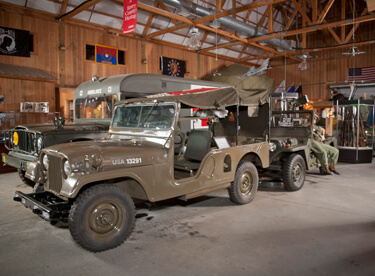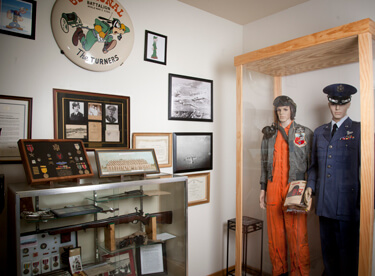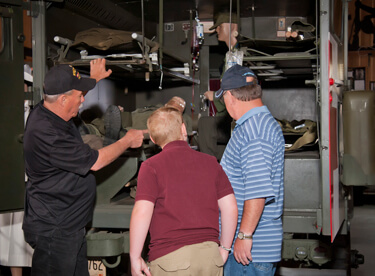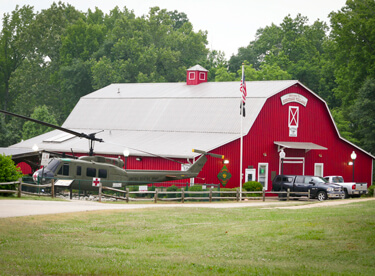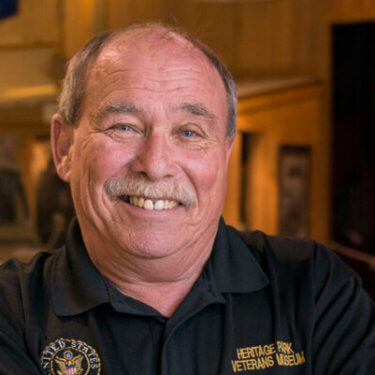
Jim Joyce
Heritage Park Veterans Museum
- Explain how the military became a career?
I was 17 when I was drafted in 1967 and was 18 years and two days old when I reported. I was told I was going into the Army. Once we had been told what branch of the service, we were given our medical evaluations, physicals and tests. From these tests we were presented with several choices of jobs.If we didn’t pick, a job was chosen for us. I chose an armor job, which was tanks. I was sent to Fort Knox, KY for basic then advanced training and then sent on the first plane to the Republic of Vietnam. My service was for a three-year program. My first tour was 12 months with an option to extend. I chose to extend my tour for another 12 months after 30 days leave. After my second tour, I was stationed in the US for seven months before my program ended and I left the military.I was out of the military for four years and worked for my father while I went to college. I went to North Texas for a degree in English. I missed the military, so I went back in the army and back in tanks. I finished my degree while in the military through the University of Maryland overseas extension program. After rejoining, I spent almost 21 years as an armor crewman. I did three tours in Germany, Ft. Bragg, Ft. Knox, Ft. Hood, Ft. Irwin and Los Angles. I also taught military science at Cal State’s Fullerton campus. - How many years were you in the military and how many tours did you serve?
24 years, one month, three weeks and two days. I retired on 1 April 1994. I served two [tours] in Vietnam and three in Europe then at various bases all over the US. - Tell me a little about your active duty experience.
I worked in tanks maintaining and training new armor soldiers. I was in the MM51 Sheridan in Vietnam, second tour in M48A1, then a M60 A1, A2 and A3 Tank, M1 Abrams A1. I spent 3 years as a Drill Sargent at Fort Knox from 1981-84, where I trained tank guys who were operating tanks for ground combat. - What does it mean to you to be a veteran?
There is a special bond among veterans. People in the American military have done things the average person has never done and seen things the average person hasn’t seen and can’t even imagine. These things especially play on the psyche. Being around other veterans allows them to talk about things that others don’t/can’t understand and it puts them in a comfort zone.There is a special bond among veterans. People in the American military have done things the average person has never done and seen things the average person hasn’t seen and can’t even imagine.
- What unique opportunities did you have due to your career?
I was able to see the world. I have been all around Europe and the USA and 15-16 different countries. I have had the opportunity to meet people around the world and around the country (USA) and have become able to assimilate into different cultures. It allowed not only me, but the whole family to learn about the world a little bit more than what you would normally get if you just stay in the States and go to school. My daughter was born in Europe and [both my kids] went to a great school in Europe. A field trip for them may be to Helderberg Castle that is 1,000 years old. They talk about the Eiffel Tower in school. My kids were able to say “yeah, I’ve been there.” - How did you become the head curator of the museum?
I was hired by Henry County in January 2010 to be the facilities coordinator. In June 2010, Tim Coley, my director asked me if I knew anything about museums because we were going to have to move the very small two-room museum from Nash Farm Park to Heritage Park.We were able to secure the barn at Heritage Park for the museum. A retired Air Force Colonel named John Anzelone and I cleaned the building up and we moved the five glass cases, nine mannequins and 15 uniforms from Nash Farm Park into the barn.We were the original and only two [at the museum] and had no clue what to do. John was a volunteer who had been volunteering at Nash Farm. We cleaned out our closets at home and brought as much of our own stuff as we could to add to the collection. We opened the doors on Veterans Day, November 11, 2010. At that point, I guess word kind of got out that we were in the process of developing a military museum at Heritage Park and that two old retired guys were in charge. That is when the flood gates opened. It was crazy and still is. There is not a week that goes by that we don’t get something new.
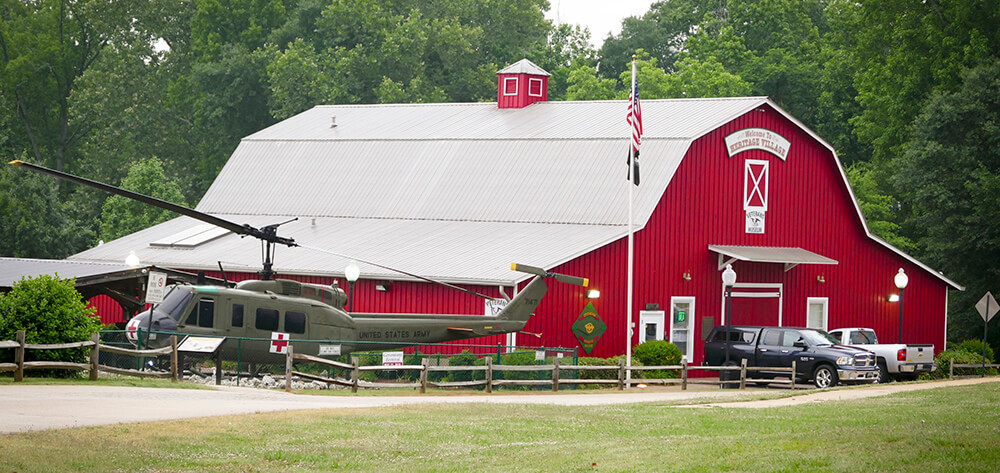
- When you were first asked to run the museum, what was your first thought?
“You’ve got to be kidding me.” I said, “Tim, I have been to several museums. I have no clue how to make or run one.”He said, “You’ll learn. I have confidence in you.”We have learned as we’ve gone along, and the rest is kind of history. - What and/or whom do you credit with the success of the museum?I think the success is the fact that someone is there to tell them [visitors] about each piece. Every single thing in that building has a story. Every piece. Do we know all the stories? No, but we know a bunch of them. So when people come, they are going to see something and learn something. Whether they are 5 years old or 95, the end result is the same. I think that is the key that has made it so successful. There is actually a couple of keys. That is number one. The second is every day when we unlock that door we make a positive change. Maybe one you can see, maybe one you can’t see, but every day there is a change made in that building. We did it the first day we opened up and we did it this morning.What it amounts to is we have all gone to museums and displays, walked in, saw what was in the building and then left, but didn’t learn anything. For us, the key is we are going to teach them [visitors] something or talk about the person who wore a uniform or used a weapon.We made each display that we have a focal point. You go some places and they may have one focal point. In this museum, each display is a focal point. If someone who comes in with a uniform to donate, the first thing we ask is “who wore it and what is the story behind it?” That adds a personal touch.
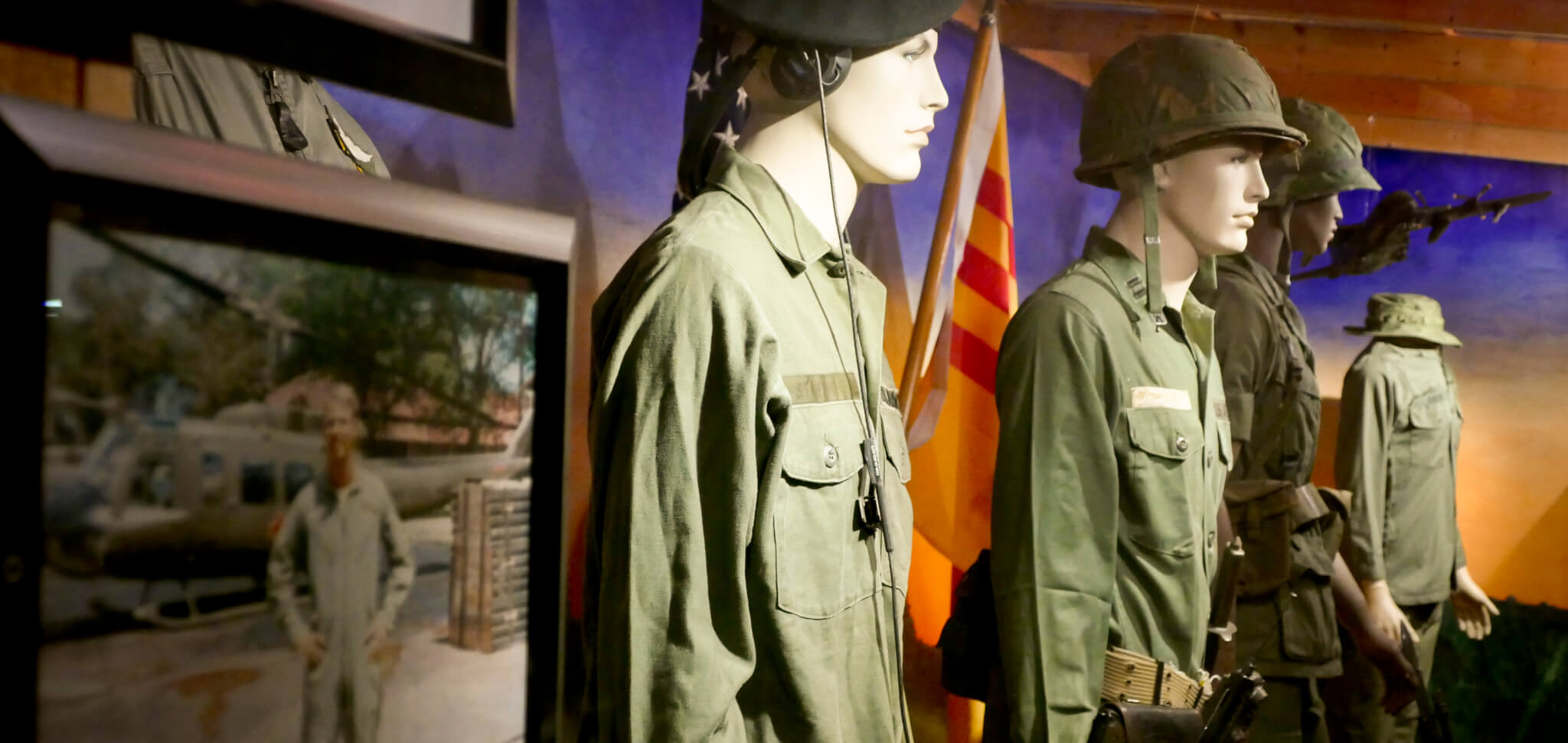
- How did the volunteer structure of the museum come about?
I really don’t know. It started with the two of us. At first we were only open three days a week – Monday, Wednesday and Friday. Someone would come in, especially if they were a veteran and retired and had nothing to do, they would get corralled [into volunteering]. That is kind of how it started. They all have a passion for it [working in the museum] and the reason they have a passion for it is because they had the same passion while they were on active duty.We would have to close the doors if it wasn’t for the volunteers we have. The building is owned by Henry County and is on a Henry County park. [Henry County] takes care of the maintenance, and other than that the work we do is through donations and volunteers. It’s crazy. In my 65 years it has been the wildest ride I have ever been on.We have volunteers from every branch of service. From a navy submariner, affectionately known as “Bubbles”to a Vietnam River Boat Captain, and from the Commander of an Air Force Hospital, to an Airborne Infantry soldier to a couple of Tankers (armored soldiers on tanks).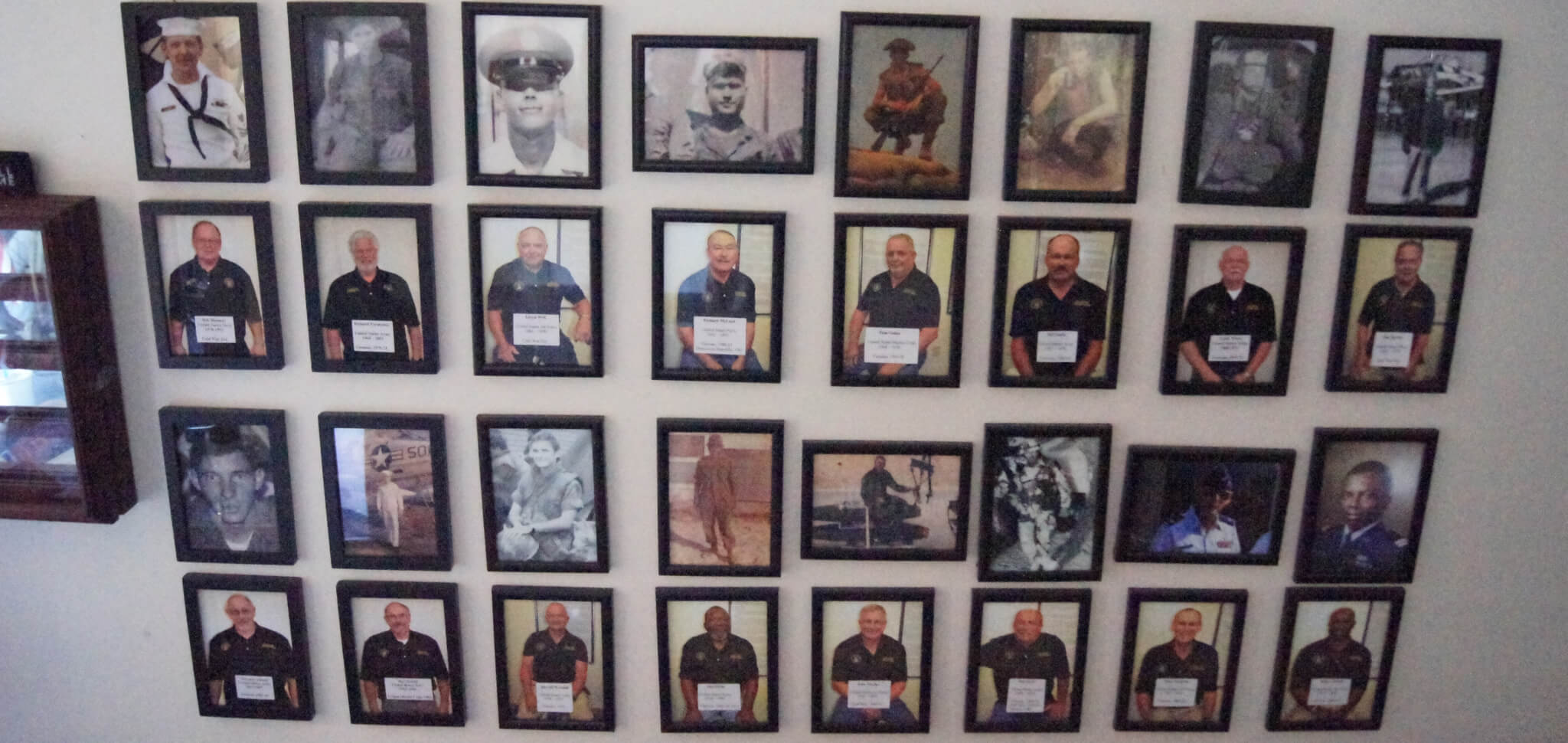
- What are you most proud of about the museum itself and what it has been able to do for the local community and the military community and their families in general?
We have become a destination. We are over 4,500 [visitors] for the year so far. That is a proud moment for me knowing that with such meager beginnings we have been able to develop it into what it is today.I know I can say that if my days were numbered and I were not here tomorrow it would continue on with the volunteer group that is there.That is a very good feeling for me. We have had several opportunities to go out and speak in the community. We’ve had speaking engagements at several churches, at several schools at several of the other veterans’ organization. We are also taking the opportunity to work with some of those veterans that are out there that need some help. We have been very lucky in that respect as well. - How do you find new pieces for the collection?
We haven’t bought a single piece. We have been so lucky that we haven’t had to go find anything, it finds us. Every piece has walked through the door or driven through in some cases. There are a couple of exceptions, the Huey outside and the gyrocopter inside. Every week someone either comes in and says “Hey, I am going to bring you this” or they show up at the door and say I got something for you. People will buy things just to put in that museum. I don’t know why it works that way but I am glad it does. We have been lucky.
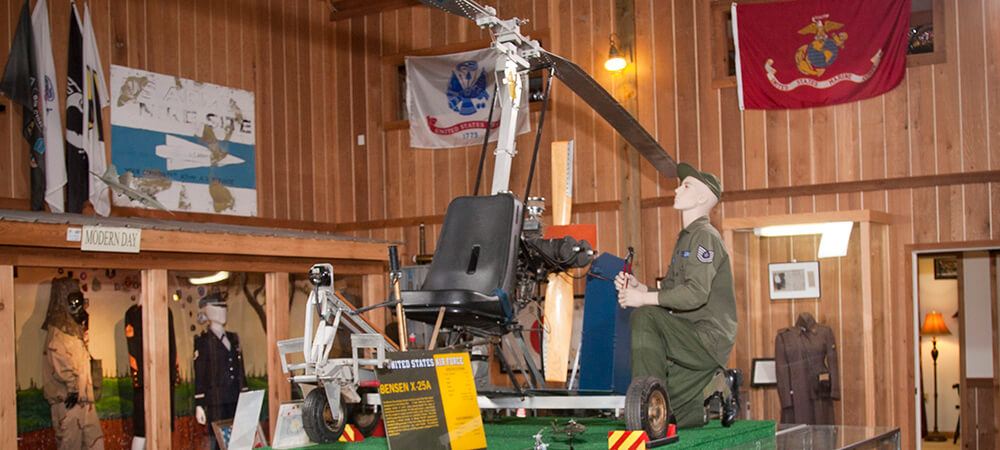
- If you had to pick one piece from the collection as your favorite what would it be and why?
There is a sweater that was hand-knitted in WWII by Evelyn Terry-Jones. During WWII almost every American had something to do with the war effort. They would collect metal and the women would work in the factories where the men used to work because the men were all off fighting the war. There were people in America who couldn’t do things like that so they found other ways to support the war effort. A young lady up in one of the northern states knitted sweaters. When she completed them she donated them to the Red Cross who in turn would sew a little label into the collar and send them overseas to help keep our fighting men and women warm. The one we have was donated very early on. In fact it was part of the stuff that was at Nash Farm Park. It is the only one left in existence that we can find. That is my favorite piece for a couple reasons. The first and most important reason is it is a classic example of how American’s banned together during WWII to support the war effort. The second reason is it’s absolutely a beautiful piece. I am not a knitting person and I don’t make things with a sewing machine. But I can understand looking at a piece how much work and effort went in to it and the detail that is in it. It looks like a machined piece but it was hand-made. - What do you think makes this museum different and was that always the intent or did it just evolve that way?
It evolved that way for sure. We didn’t set out to make it different. We didn’t know how. We had no clue. As we went along we kind of figured it out.Once that happened we knew we were on the road to success. What we didn’t know was how big it was really going to be. It is crazy. It used to be a place to visit if you have time. Now it is a place you have to visit. It is a destination in this county now. And I will tell you it is not because of me at all. It is because of the volunteers. The guys having the right kind of vision. Having the right kind of volunteer come through the door. The fact that we are supported by the community and supported by the county and the city as well. Every county commissioner and most of the staff as well have been through. Love of country is the “it” factor for the museum. Not only by the people who work there but by the people who come through the door. Never in nearly six years of being open have we had a compliant. Ever. The only thing we hear is that we need to be bigger and open on Sunday.The goal is to maintain and preserve and show and display military history and when you say military history it’s not like the history of a building – it’s the history of people.
- What do you see as the goal or mission of the museum?
The goal is to maintain and preserve and show and display military history and when you say military history it’s not like the history of a building – it’s the history of people. That is the premise behind if you bring me a uniform I want to know the story. If you bring me a piece I want to know the story.
